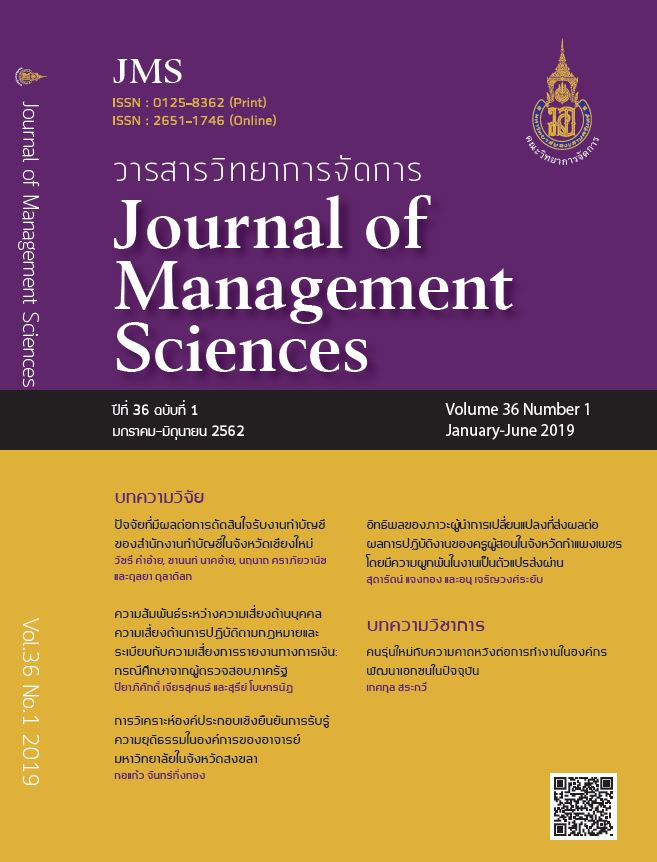Confirmatory Factor Analysis of Perceived Organizational Justice among University Lecturers in Songkhla Province
Main Article Content
Abstract
The purpose of this study was to examine the goodness of fit model of perceived organizational justice among university lecturers in Songkhla Province. Data were collected from 400 university lecturers in Songkhla Province which include Thaksin University, Songkhla Rajabhat University, Rajamangala University of Technology Srivijaya, Prince of Songkla University, and Hatyai University. The 5 rating scale questionnaire with 18 question items was employed. The reliability of the questionnaire ranged from .90 to .94. The data were analyzed with second order confirmatory factor analysis. The result revealed that perceived organizational justice of university lecturers in Songkhla Province consisted of 3 main components: (1) distributive justice, consisted of 5 sub-components (2) procedural justice, consisted of 7 sub-components, and (3) interactional justice, consisted of 6 sub-components, and these main components were consistent with the empirical data: X2 (df = 123) = 372.20 sig = 0.00, X2/df = 3.03, CFI = 0.98, NNFI = 0.97, RMSEA = 0.07, SRMR = 0.05. The weight of 3 main components and 18 sub-components were between .84 to .99 and .61 to .83, respectively. This is an empirical evidence that there are 3 main components for measuring perceived organizational justice. Findings of this research can be applied to motivate employees to push their performance.
Article Details

This work is licensed under a Creative Commons Attribution-NonCommercial-NoDerivatives 4.0 International License.
All published articles are SJMS’s copyright. The editorial board allows all published articles to be copied, excerpted, or disseminated with academic citation.
References
Bies, R. J. & Moag, J. F. (1986). Interactional justice: Communication criteria of fairness. In R. J. Lewicki, B. H. Sheppard, & M. H. Bazerman (Eds.), Research on Negotiations in Organizations (pp. 43-55). Greenwich, CT: JAI Press.
Cohen-Charash, Y. & Spector, P. E. (2001). The role of justice in organizations: A meta analysis. Organizational Behavior and Human Decision Processes, 86(2), 278-321.
Colquitt, J. A. (2001). On the dimensionality of organizational justice: A construct validation of a measure. Journal of Applied Psychology, 86(3), 386-400.
De Cremer, D., Van Dijke, M., & Bos, A. E. R. (2007). When leaders are seen as transformational: The effects of organizational justice. Journal of Applied Social Psychology, 37(8), 1797-1816.
Diamantopoulos, A. & Siguaw, J. A. (2000). Introducing LISREL: A guide for the uninitiated. Thousan Oaks. CA: Sage.
Fiaz, M., Ikram, A., Su, Q., & Ali, N. (2018). How to save the saviors?: Relationship between organizational justice and citizenship behavior. The Journal of Developing Areas, 52(1), 45-58.
Folger, R. & Greenberg, J. (1985). Procedural justice: An interpretive analysis of personnel system. In K. M. Rowland & G. R. Ferris (Eds.), Research in personnel and human resource management (pp. 141-183). Greenwich, CT: JIT Press.
Hair, J. F., Black, W. C., Babin, B. J., & Anderson, R. E. (2010). Multivariate data analysis: A global perspective. (7th ed.) Upper Saddle River, NJ: Pearson Education.
Inoue, A., Kawakami, N., Tsutsumi, A., Shimazu, A., Tsuchiya, M., Ishizaki, M., et al. (2009). Reliability and validity of the Japanese version of the organizational justice questionnaire. Journal of Occupational Health, 51(1), 74-83.
Jankingthong, K. (2016). Structural equation model of the relationship of behavior toward the polices’ performance in Southern Border Province of Thailand, Journal of Management Science. 33(1), 1-24.
Kline, R. B. (2011). Principle and practice of structural equation modeling. (3rd ed.). New York, NY: Guilford.
Kreitner, R. & Kinicki, A. (2004). Organizational behavior. (6th ed.). New York, NY: McGraw-Hill.
Lakpetch, P. (2014). Multi-level confirmatory factor analysis of five-forces model in hotel industry of Thailand for ASEAN Economic Community. Journal of Research Methodology, 27(3), 281-301.
Moorman, R. H. (1991). Relationship between organizational justice and organizational citizenship behaviors: Do fairness perceptions influence employee citizenship?. Journal of Applied Psychology, 76(6), 845-855.
Muchinsky, P. M. (2006). Psychology applied to work: An introduction to industrial and organizational psychology (8th ed.). Belmont, CA: Thomson/Wadsworth.
Ngudgratoke, S. (2014). Analysis for applied research (2nd ed.).Journal of Research Methodology, 27(3), 363-368.
Niehoff, B. P. & Moorman, R. H. (1993). Justice as a mediator of the relationship between methods of monitoring and organizational citizenship behavior. Academy of Management Journal, 36(3), 527-556.
Noklang, S., Srisuantang, S., & Tonpichai, P. (2015). A confirmatory factor analysis model of adversity quotient among third year students in the five-year teacher education course at Prince of Songkla University, Pattani Campus. Journal of Liberal Arts, 7(1), 109-125.
Robbins, S. P. (2003). Organizational behavior. (10th ed.). Upper Saddle River, NJ: Pearson Education.
Schumacker, R. E. & Lomax, R. G. (2010). A beginner’s guide to structural equation modeling (3rd ed.). New York, NY: Taylor & Francis.
Somanandana, V., Purananon, D., Wongnam, P., & Surasret, C. (2016). Confirmatory factor analysis of Tri-Sikkhara characteristics of college students. Suthiparithat, 30(94), 168-179.
Sutanto, E. M., Scheller-Sampson, J., & Mulyono, F. (2018). Organizational justice work environment and motivation. International Journal of Business and Society, 19(2). 313-322.
Wang, X., Liao, J., Xia, D., & Chang, T. (2010). The impact of organizational justice on work performance. International Journal of Manpower, 31(6), 660-677.
